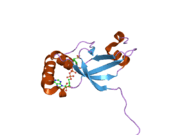SRXN1
Sulfiredoxin-1 is a protein that in humans is encoded by the SRXN1 gene.[5]
References
Further reading
- Hartley JL, Temple GF, Brasch MA (2001). "DNA cloning using in vitro site-specific recombination". Genome Res. 10 (11): 1788–95. doi:10.1101/gr.143000. PMC 310948. PMID 11076863.
- Venter JC, Adams MD, Myers EW, et al. (2001). "The sequence of the human genome". Science. 291 (5507): 1304–51. doi:10.1126/science.1058040. PMID 11181995.
- Wiemann S, Weil B, Wellenreuther R, et al. (2001). "Toward a catalog of human genes and proteins: sequencing and analysis of 500 novel complete protein coding human cDNAs". Genome Res. 11 (3): 422–35. doi:10.1101/gr.GR1547R. PMC 311072. PMID 11230166.
- Deloukas P, Matthews LH, Ashurst J, et al. (2002). "The DNA sequence and comparative analysis of human chromosome 20". Nature. 414 (6866): 865–71. doi:10.1038/414865a. PMID 11780052.
- Strausberg RL, Feingold EA, Grouse LH, et al. (2003). "Generation and initial analysis of more than 15,000 full-length human and mouse cDNA sequences". Proc. Natl. Acad. Sci. U.S.A. 99 (26): 16899–903. doi:10.1073/pnas.242603899. PMC 139241. PMID 12477932.
- Chang TS, Jeong W, Woo HA, et al. (2005). "Characterization of mammalian sulfiredoxin and its reactivation of hyperoxidized peroxiredoxin through reduction of cysteine sulfinic acid in the active site to cysteine". J. Biol. Chem. 279 (49): 50994–1001. doi:10.1074/jbc.M409482200. PMID 15448164.
- Gerhard DS, Wagner L, Feingold EA, et al. (2004). "The status, quality, and expansion of the NIH full-length cDNA project: the Mammalian Gene Collection (MGC)". Genome Res. 14 (10B): 2121–7. doi:10.1101/gr.2596504. PMC 528928. PMID 15489334.
- Wiemann S, Arlt D, Huber W, et al. (2004). "From ORFeome to biology: a functional genomics pipeline". Genome Res. 14 (10B): 2136–44. doi:10.1101/gr.2576704. PMC 528930. PMID 15489336.
- Woo HA, Jeong W, Chang TS, et al. (2005). "Reduction of cysteine sulfinic acid by sulfiredoxin is specific to 2-cys peroxiredoxins". J. Biol. Chem. 280 (5): 3125–8. doi:10.1074/jbc.C400496200. PMID 15590625.
- Jönsson TJ, Murray MS, Johnson LC, et al. (2005). "Structural basis for the retroreduction of inactivated peroxiredoxins by human sulfiredoxin". Biochemistry. 44 (24): 8634–42. doi:10.1021/bi050131i. PMC 3928543. PMID 15952770.
- Mehrle A, Rosenfelder H, Schupp I, et al. (2006). "The LIFEdb database in 2006". Nucleic Acids Res. 34 (Database issue): D415–8. doi:10.1093/nar/gkj139. PMC 1347501. PMID 16381901.
- Jeong W, Park SJ, Chang TS, et al. (2006). "Molecular mechanism of the reduction of cysteine sulfinic acid of peroxiredoxin to cysteine by mammalian sulfiredoxin". J. Biol. Chem. 281 (20): 14400–7. doi:10.1074/jbc.M511082200. PMID 16565085.
- Findlay VJ, Townsend DM, Morris TE, et al. (2006). "A novel role for human sulfiredoxin in the reversal of glutathionylation". Cancer Res. 66 (13): 6800–6. doi:10.1158/0008-5472.CAN-06-0484. PMID 16818657.
This article is issued from
Wikipedia.
The text is licensed under Creative Commons - Attribution - Sharealike.
Additional terms may apply for the media files.








